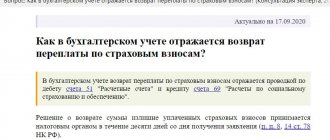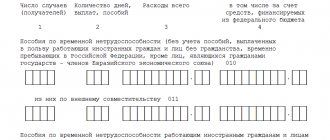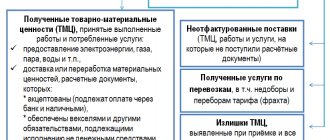Contributions for injuries are regular money transfers that the employer makes to the Social Insurance Fund for employees. If an employee is injured at work, the Fund will pay him compensation for harm to health. The rules for paying contributions are prescribed in Law of 1998 No. 125-FZ.
Contributions are transferred monthly for each employee, the amount depends on the size of the salary and several other factors:
- the type of activity that determines the contribution rate;
- tariffs for contributions approved by the Social Insurance Fund;
- relief on contributions for injuries or an increase in the tariff.
What conditions determine the payment of contributions?
Contributions for injuries must be paid if you have entered into an employment contract with an employee. When concluding a civil contract, you can include in it a condition regarding “accidental” contributions, and then they will also have to be paid. If there is no such condition in the GPC agreement, then contributions to the Social Insurance Fund are not transferred.
The transfer of contributions does not depend on whether the employee is a citizen or resident of our country.
The insurer for this type of insurance is the Social Insurance Fund, and the policyholder is the employer: a legal entity, entrepreneur or individual who has signed an employment agreement with the employee.
How is the basis for calculating contributions for injuries formed?
Contributions to Social Security are made from different types of earnings: wages, bonuses, allowances, compensation for unused vacation, and even when paying wages in kind (in this case, the amount for calculating contributions is taken that is specified in the contract).
The following types of payments are not included in the base for calculating contributions:
- payments upon reduction or liquidation of a company;
- state capacity;
- remunerations paid for work in particularly dangerous and difficult health conditions;
- payment for training or advanced training;
- financial assistance in force majeure circumstances.
Keep records of exports and imports in the Kontur.Accounting web service. Simple accounting, payroll and reporting in one service
How the tariff for “unfortunate” contributions is determined
The contribution rate for work-related injuries and illnesses ranges from 0.2% to 8.5%. The higher the degree of risk in the company’s core activities, the higher the rate (Article 1 of Law No. 179-FZ of 2005).
There are 32 tariffs that reflect the risks of different areas of activity. Each type is assigned to a specific risk class in the Classification approved by Order of the Ministry of Labor of Russia dated December 30, 2016 N 851n. We talk about this in more detail in our article.
You can determine the risk class of an enterprise when starting its activities using the main OKVED code, which is indicated in the registration documents. Each year, the risk class may change if the main activity that brings the company maximum profit changes.
To confirm the main type of activity, individual entrepreneurs and companies annually submit a special notification to the territorial Social Insurance Fund (clause 3 of the Procedure, approved by Order of the Ministry of Health and Social Development dated January 31, 2006 No. 55). The application and package of documents are submitted in paper or electronic form:
- statement confirming the main type of activity;
- certificate confirming the main type of activity;
- for medium and large businesses - a copy of the explanatory note to the balance sheet for the past year.
Insurance rates
There are as many insurance rates as there are established professional risk groups - 32. Their size is established by federal law. Federal Law No. 179-FZ of December 22, 2005 established insurance rates. These are the tariffs:
| I class of professional risk | 0,2 | ||
| II class of professional risk | 0,3 | ||
| III class of professional risk | 0,4 | ||
| IV class of professional risk | 0,5 | ||
| V class of professional risk | 0,6 | ||
| VI class of professional risk | 0,7 | ||
| VII class of professional risk | 0,8 | ||
| VIII class of professional risk | 0,9 | ||
| IX class of professional risk | 1,0 | ||
| X occupational risk class | 1,1 | ||
| XI class of professional risk | 1,2 | ||
| XII class of professional risk | 1,3 | ||
| XIII class of professional risk | 1,4 | ||
| XIV class of professional risk | 1,5 | ||
| XV professional risk class | 1,7 | ||
| XVI class of professional risk | 1,9 | ||
| XVII class of professional risk | 2,1 | ||
| XVIII class of professional risk | 2,3 | ||
| XIX class of professional risk | 2,5 | ||
| XX class of professional risk | 2,8 | ||
| XXI class of professional risk | 3,1 | ||
| XXII class of professional risk | 3,4 | ||
| XXIII class of professional risk | 3,7 | ||
| XXIV professional risk class | 4,1 | ||
| XXV occupational risk class | 4,5 | ||
| XXVI class of professional risk | 5,0 | ||
| XXVII class of professional risk | 5,5 | ||
| XXVIII class of professional risk | 6,1 | ||
| XXIX professional risk class | 6,7 | ||
| XXX professional risk class | 7,4 | ||
| XXXI occupational risk class | 8,1 | ||
| XXXII professional risk class | 8,5 |
What are the surcharges and discounts on tariffs?
The Social Insurance Fund has the right to increase or decrease the tariff. The methodology for accurately calculating the premium or discount is prescribed in the order of the Ministry of Labor dated 01.08.2012 No. 39n, and it is used by the territorial branches of the Fund.
To calculate the exact rate, the FSS compares industry safety indicators and your company’s indicators. This is the number of insured events per 1000 employees, the number of sick days per insured event, the ratio of the Fund's expenses for paying compensation to the company's employees and the amount of contributions paid for this company. The Fund also takes into account information about medical examinations and the results of a special assessment of working conditions. For 2021, the FSS approved the indicators by resolution No. 107 dated June 25, 2020.
Keep records of exports and imports in the Kontur.Accounting web service. Simple accounting, payroll and reporting in one service
The amount of insurance premiums for individual entrepreneurs in 2015
Individual entrepreneurs pay insurance premiums for themselves in a special way - in the form of a so-called fixed payment. Its final size depends on the minimum wage established for the corresponding year, as well as on the amount of income received during the year.
“What insurance premiums does an individual entrepreneur pay in 2014–2015?” will help you calculate this fixed payment for 2015, and also check whether it was paid correctly for the previous year. .
And if you are already planning expenses for 2021, then remember that you need to calculate insurance premiums at the new minimum wage.
Information about its value is in the material “In 2021 - a new minimum wage” .
How to get a discount on a tariff
To receive a discount, a business must meet three requirements:
- work for three years or more;
- have no debts on “unfortunate” contributions, penalties and fines;
- Last year, no people died at the enterprise (except for accidents caused by third parties).
The fund determines the discount percentage based on the company's performance over three years. To receive a discount, you must submit an application before November 1, 2021 (FSS order No. 231 dated April 25, 2019). Until December 1, 2021, the Fund will give you a discount or refuse it and notify you about it. After this, calculate the tariff rate using the formula:
Tariff according to OKVED * (100 - discount)%
What else will this subsection tell you about?
In this subsection, we try to cover all the latest news and important changes in terms of SV tariffs. For example, do you know which feed-in tariffs have been discontinued since 2015? If not, see the note “Some beneficiaries ended using reduced premium rates in 2014. ” Make sure you do not fall into this category of policyholders.
If you previously applied for benefits for disabled employees, see the article “Amounts of insurance premiums for disabled people in 2014–2015 .
Check that you have calculated all contributions correctly.
Follow the news of this subsection of the site. If there is anything new regarding insurance premium rates, we will definitely inform you about it.
What's new
Employers make “injury” contributions in accordance with insurance rates. However, a discount or surcharge may be applied to the tariff (clause 1, article 22 of the Federal Law of July 24, 1998 No. 125-FZ).
The size of the discount (surcharge) is determined by a formula that involves three indicators:
- The ratio of the Social Insurance Fund's expenses for the payment of benefits for all insured events for the policyholder and the total amount of accrued contributions;
- Number of insured events per thousand employees;
- The number of days of temporary disability for the policyholder per insured event (excluding cases of death).
The average values of these indicators by type of economic activity for 2021 were approved by Resolution of the Federal Tax Service of the Russian Federation dated May 31, 2017 No. 67. For example, for retail trade in food products, drinks and tobacco products in specialized stores, the indicated values are 0.07, 0.46 and 48.67, respectively .
| Change | Content |
| Expanding the rights of the Social Insurance Fund | Since 2021, the Social Insurance Fund has the following rights: • demand explanations from policyholders regarding contributions; • maintain control over the receipt of funds; • calculate the amount of insurance premiums, etc. |
| The collection procedure has been established | The Basic Law - 1998 No. 125-FZ - was supplemented with new articles that regulate methods of collecting arrears, deferments, accrual of penalties, etc. |
| The calculation procedure has been specified | Terms, as well as settlement and reporting periods, are determined at the legislative level |
| Control over payment of contributions has been tightened | Law No. 125-FZ has been supplemented with rules on conducting desk audits, recording audit results, etc. |
Also see: Reimbursement of Workwear Costs through Contributions: What Has Changed.
Legislation in the field of insurance premiums is periodically adjusted, and officials of the Ministry of Finance and the Federal Tax Service interpret it in their own way. Here are some of the changes (actual and planned) and clarifications:
- From 01/01/2018, individual entrepreneurs’ contributions to the Pension Fund are not tied to the level of the minimum wage and are fixed in the form of fixed amounts for the coming years (2018–2020) in Art. 430 Tax Code of the Russian Federation:
- Officials of the Ministry of Finance in a letter dated 02.12.2018 No. 03-15-07/8369 (sent by a letter of the Federal Tax Service dated 02.21.2018 No. GD-4-11/) prohibited individual entrepreneurs in special modes (STS, UTII and patent) from reducing income received by expenses when calculating contributions. And only individual entrepreneurs on the general taxation system are allowed to do this. At the same time, the Federal Tax Service previously confirmed the possibility of simplifiers using the “income minus expenses” object to pay 1% to the Pension Fund of the Russian Federation on the difference between income and expenses (review of the legal positions of the Constitutional and Supreme Courts, approved by the Federal Tax Service of Russia on January 23, 2018).
- It is likely that soon policyholders will have to prepare reports on contributions (ERSV) on an updated form (at the time of writing, the draft order of the Federal Tax Service is at the stage of public discussion).
- It is planned that residents of TOP (advanced development territories) and residents of the free port of Vladivostok will be able to apply reduced rates on insurance premiums for 10 years from the period of acquiring such status.
The link to the bill is posted here.
Find out about tax innovations in our section.
The size of the insurance rate is also affected by discounts and surcharges. They are set by the FSS as a percentage of the insurance rate according to the rules approved by Decree of the Government of the Russian Federation of May 30, 2012 No. 524. The company can save on accident premiums by asking the fund for a discount. The amount of the discount or premium cannot exceed 40% of the insurance rate established for the policyholder.
The fund calculates discounts based on the following performance indicators of the organization for the three years preceding the current one:
- the ratio of the amounts paid in connection with all insured events that occurred to the policyholder to the accrued amount of insurance premiums;
- number of insurance cases in the organization per 1000 employees;
- the number of days of temporary disability in the organization per insured event (excluding cases of death).
The procedure for determining these indicators is established by the Methodology for calculating discounts and allowances, approved by Order of the Ministry of Labor of Russia dated August 1, 2012 No. 39n and in force since September 18, 2012.
When setting a discount, the following information is taken into account:
- on the results of a special assessment of working conditions;
- on mandatory preliminary and periodic medical examinations of employees as of January 1 of the year for which the discount is established.
If at the beginning of the year the company did not conduct a special assessment of workplaces, then it has no chance of receiving a discount.
A company that:
- pays current insurance premiums on time;
- on the date of filing the application for establishing a discount (no later than November 1) has no debt on insurance premiums.
To receive a discount, the company must submit documents to the territorial office of the Social Insurance Fund no later than November 1 of the year preceding the year for which the discount is established. No later than December 1, the fund must decide whether to provide a discount or not. The fund will inform the applicant about its decision within five days from the date of its adoption.
The discount amount is set as a percentage of the insurance rate and rounded to the nearest whole value.
If a negative decision is made, the FSS will send a notification of refusal also within five days from the date of the decision.
The amount of the insurance tariff with a discount = The discounted tariff established for the company – Discount on the tariff
PRIMERAO "Aktiv" is engaged in the production of construction equipment (OKVED code 29.22.2) and belongs to the XVII class of professional risk. For this class, a tariff of 2.1% of wages is established. Aktiva's wage fund is 900,000 rubles per month. On October 10 of the reporting year, Aktiv JSC sent documents to the Social Insurance Fund to provide a discount on the tariff. The Social Insurance Fund decided to provide a 30% discount on the insurance tariff. The company’s new insurance tariff will be: 2.1% - (2.1% × 30%) = 1.47% Let's calculate how much the company will save over the year as a result of the discount received: 900,000 rubles/month. H 12 months H 2.1% = 226,800 rub. (the amount of contributions that had to be paid without a discount). RUB 900,000/month. H 12 months H 1.47% = 158,760 rub. (the amount of contributions that must be paid taking into account the discount). As a result, the company will save 68,040 rubles over the year. (226,800 – 158,760).
Tariff surcharge
The decision to establish a premium for the policyholder for the next financial year is made by the insurer no later than September 1 of the current financial year. The fund makes this decision independently if the data calculated by it for the policyholder exceeds the average values of similar indicators in the industry to which its main type of activity belongs.







